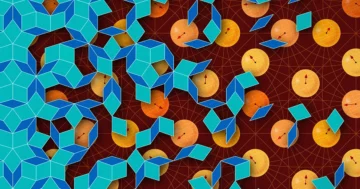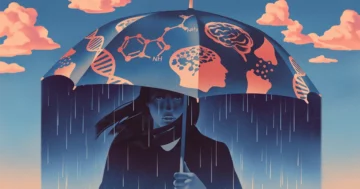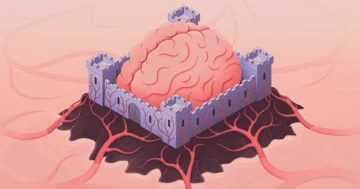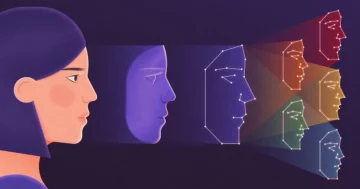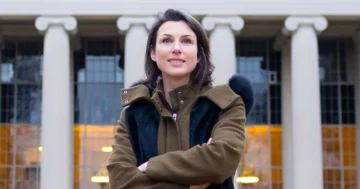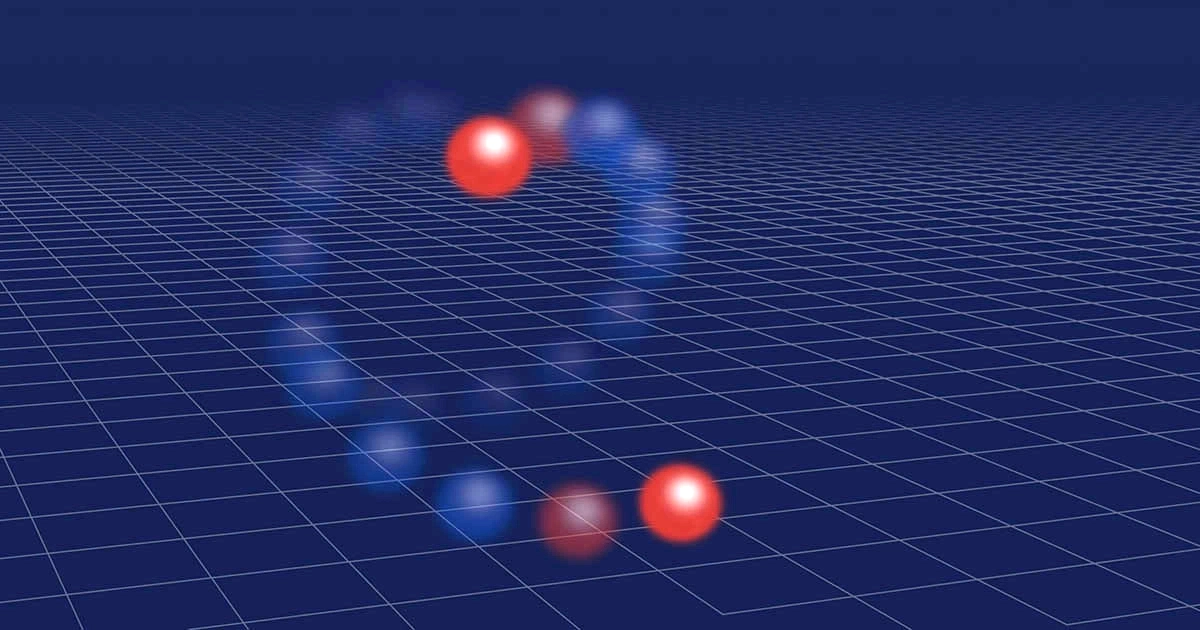
Introduction
Forty years ago, Frank Wilczek was mulling over a bizarre type of particle that could live only in a flat universe. Had he put pen to paper and done the calculations, Wilczek would have found that these then-theoretical particles held an otherworldly memory of their past, one woven too thoroughly into the fabric of reality for any one disturbance to erase it.
However, seeing no reason that nature should allow such strange beasts to exist, the future Nobel prize-winning physicist chose not to follow his thought experiments to their most outlandish conclusions — despite the objections of his collaborator Anthony Zee, a renowned theoretical physicist at the University of California, Santa Barbara.
“I said, ‘Come on, Tony, people are going to make fun of us,’” said Wilczek, now a professor at the Massachusetts Institute of Technology.
Others weren’t so reluctant. Researchers have spent millions of dollars over the past three decades or so trying to capture and tame the particlelike objects, which go by the cryptic moniker of non-abelian anyons.
Now two landmark experiments have finally succeeded, and no one is laughing. “This has been a target, and now it’s hit,” Wilczek said.
Physicists working with the company Quantinuum announced today that they had used the company’s newly unveiled, next-generation H2 processor to synthesize and manipulate non-abelian anyons in a novel phase of quantum matter. Their work follows a preprint posted last fall in which researchers with Google celebrated the first clear intertwining of non-abelian objects, a proof of concept that information can be stored and manipulated in their shared memory. Together, the experiments flex the growing muscle of quantum devices while offering a potential glimpse into the future of computing: By maintaining nearly indestructible records of their journeys through space and time, non-abelian anyons could offer the most promising platform for building error-tolerant quantum computers.
Introduction
“As pure science, it’s just, wow,” said Ady Stern, a condensed matter theorist at the Weizmann Institute of Science in Israel who has spent his career studying the objects. “This brings you closer [to topological quantum computing]. But if there’s one thing the last few decades have shown us, it’s a long and winding road.”
Flatland Computing
In 1982, Wilczek helped open physicists’ minds to the menagerie of particles that could exist in two dimensions. He worked out the consequences of confining quantum laws to a hypothetical, entirely flat universe, and found that it would contain strange particles with fractional spins and charges. Moreover, swapping otherwise indistinguishable particles could change them in ways that were impossible for their three-dimensional counterparts. Wilczek cheekily named these two-dimensional particles anyons, since they seemed to be capable of nearly anything.
Wilczek focused on the simplest “abelian” anyons, particles that, when swapped, change in subtle ways that are not directly detectable.
He stopped short of exploring the wilder option — non-abelian anyons, particles that share a memory. Swapping the positions of two non-abelian anyons produces a directly observable effect. It switches the state of their shared wave function, a quantity that describes a system’s quantum nature. If you stumble upon two identical non-abelian anyons, by measuring which state they are in, you can tell whether they have always been in those positions or whether they’ve crossed paths — a power no other particle can claim.
To Wilczek, that notion seemed too fantastical to develop into a formal theory. “What kinds of states of matter support those?” he recalled thinking.
But in 1991, two physicists identified those states. They predicted that, when subjected to strong enough magnetic fields and cold enough temperatures, electrons stuck to a surface would swirl together in just the right way to form non-abelian anyons. The anyons would not be fundamental particles — our 3D world forbids that — but “quasiparticles.” These are collections of particles, but they are best thought of as individual units. Quasiparticles have precise locations and behaviors, just as collections of water molecules produce waves and whirlpools.
Introduction
In 1997, Alexei Kitaev, a theorist at the California Institute of Technology, pointed out that such quasiparticles could lay the perfect foundation for quantum computers. Physicists have long salivated at the possibility of harnessing the quantum world to perform calculations beyond the reach of typical computers and their binary bits. But qubits, the atomlike building blocks of quantum computers, are fragile. Their wave functions collapse at the lightest touch, erasing their memories and their ability to perform quantum calculations. This flimsiness has complicated ambitions to control qubits long enough for them to finish lengthy calculations.
Kitaev realized that the shared memory of non-abelian anyons could serve as an ideal qubit. For starters, it was malleable. You could change the state of the qubit — flipping a zero to a one — by exchanging the positions of the anyons in a manner known as “braiding.”
You could also read out the state of the qubit. When the simplest non-abelian anyons are brought together and “fused,” for instance, they will emit another quasiparticle only if they have been braided. This quasiparticle serves as a physical record of their crisscrossed journey through space and time.
And crucially, the memory is also nigh incorruptible. As long as the anyons are kept far apart, poking at any individual particle won’t change the state the pair is in — whether zero or one. In this way, their collective memory is effectively cut off from the cacophony of the universe.
“This would be the perfect place to hide information,” said Maissam Barkeshli, a condensed matter theorist at the University of Maryland.
Unruly Electrons
Kitaev’s proposal came to be known as “topological” quantum computing because it relied on the topology of the braids. The term refers to broad features of the braid — for example, the number of turns — that aren’t affected by any specific deformation of their path. Most researchers now believe that braids are the future of quantum computing, in one form or another. Microsoft, for instance, has researchers trying to persuade electrons to form non-abelian anyons directly. Already, the company has invested millions of dollars into building tiny wires that — at sufficiently frigid temperatures — should host the simplest species of braidable quasiparticles at their tips. The expectation is that at these low temperatures, electrons will naturally gather to form anyons, which in turn can be braided into reliable qubits.
After a decade of effort, though, those researchers are still struggling to prove that their approach will work. A splashy 2018 claim that they had finally detected the simplest type of non-abelian quasiparticle, known as “Majorana zero modes,” was followed by a similarly high-profile retraction in 2021. The company reported new progress in a 2022 preprint, but few independent researchers expect to see successful braiding soon.
Similar efforts to turn electrons into non-abelian anyons have also stalled. Bob Willett of Nokia Bell Labs has probably come the closest in his attempts to corral electrons in gallium arsenide, where promising but subtle signs of braiding exist. The data is messy, however, and the ultracold temperature, ultrapure materials, and ultrastrong magnetic fields make the experiment tough to reproduce.
“There has been a long history of not observing anything,” said Eun-Ah Kim of Cornell University.
Wrangling electrons, however, is not the only way to make non-abelian quasiparticles.
“I had given up on all of this,” said Kim, who spent years coming up with ways to detect anyons as a graduate student and now collaborates with Google. “Then came the quantum simulators.”
Compliant Qubits
Quantum processors are changing the hunt for anyons. Instead of trying to coax hordes of electrons to fall into line, in recent years researchers have begun using the devices to bend individual qubits to their will. Some physicists consider these efforts simulations, because the qubits inside the processor are abstractions of particles (while their physical nature varies from lab to lab, you can visualize them as particles spinning around an axis). But the quantum nature of the qubits is real, so — simulations or not — the processors have become playgrounds for topological experiments.
“It breathes new life” into the field, said Fiona Burnell, a condensed matter theorist at the University of Minnesota, “because it’s been so hard to make solid-state systems.”
Synthesizing anyons on quantum processors is an alternate way to leverage the power of Kitaev’s braids: Accept that your qubits are mediocre, and correct their errors. Today’s shoddy qubits don’t work for very long, so anyons built from them would also have short lifetimes. The dream is to quickly and repeatedly measure groups of qubits and correct errors as they crop up, thereby extending the life span of the anyons. Measurement erases an individual qubit’s quantum information by collapsing its wave function and turning it into a classical bit. That would happen here too, but the important information would remain untouchable — hidden in the collective state of many anyons. In this way, Google and other companies hope to shore up qubits with fast measurements and swift corrections (as opposed to low temperatures).
“Ever since Kitaev,” said Mike Zaletel, a condensed matter physicist at the University of California, Berkeley, “this has been the way people think quantum error correction will likely work.”
Google took a major step toward quantum error correction in the spring of 2021, when researchers assembled about two dozen qubits into the simplest grid capable of quantum error correction, a phase of matter known as the toric code.
Creating the toric code on Google’s processor amounts to forcing each qubit to strictly cooperate with its neighbors by gently nudging them with microwave pulses. Left unmeasured, a qubit points in a superposition of many possible directions. Google’s processor effectively cut down on those options by making each qubit coordinate its spin axis with its four neighbors in specific ways. While the toric code has topological properties that can be used for quantum error correction, it doesn’t natively host non-abelian quasiparticles. For that, Google had to turn to a strange trick long known to theorists: certain imperfections in the grid of qubits, dubbed “twist defects,” can acquire non-abelian magic.
Last fall, Kim and Yuri Lensky, a theorist at Cornell, along with Google researchers, posted a recipe for easily making and braiding pairs of defects in the toric code. In a preprint posted shortly after, experimentalists at Google reported implementing that idea, which involved severing connections between neighboring qubits. The resulting flaws in the qubit grid acted just like the simplest species of non-abelian quasiparticle, Microsoft’s Majorana zero modes.
“My initial reaction was ‘Wow, Google just simulated what Microsoft is trying to build. It was a real flexing moment,” said Tyler Ellison, a physicist at Yale University.
By tweaking which connections they cut, the researchers could move the deformations. They made two pairs of non-abelian defects, and by sliding them around a five-by-five-qubit chessboard, they just barely eked out a braid. The researchers declined to comment on their experiment, which is being prepared for publication, but other experts praised the achievement.
“In a lot of my work, I’ve been doodling similar-looking pictures,” Ellison said. “It’s amazing to see that they actually demonstrated this.”
Paint by Measurement
All the while, a group of theorists headed up by Ashvin Vishwanath at Harvard University was quietly pursuing what many consider an even loftier goal: creating a more complicated phase of quantum matter where true non-abelian anyons — as opposed to defects — arise natively in a pristine phase of matter. “[Google’s] defect is kind of a baby non-abelian thing,” said Burnell, who was not involved in either effort.
Anyons of both types live in phases of matter with a topological nature defined by intricate tapestries of gossamer threads, quantum connections known as entanglement. Entangled particles behave in a coordinated way, and when trillions of particles become entangled, they can ripple in complicated phases sometimes likened to dances. In phases with topological order, entanglement organizes particles into loops of aligned spins. When a loop is cut, each end is an anyon.
Topological order comes in two flavors. Simple phases such as the toric code have “abelian order.” There, loose ends are abelian anyons. But researchers seeking true non-abelian anyons have their sights set on a completely different and much more complicated tapestry with non-abelian order.
Vishwanath’s group helped cook up a phase with abelian order in 2021. They dreamt of going further, but stitching qubits into non-abelian entanglement patterns proved too intricate for today’s unstable processors. So the crew scoured the literature for fresh ideas.
They found a clue in a pair of papers from decades before. Most quantum devices compute by massaging their qubits much as one might fluff a pillow, in a gentle way where no stuffing flies out through the seams. Carefully knitting entanglement through these “unitary” operations takes time. But in the early 2000s Robert Raussendorf, a physicist now at the University of British Columbia, hit on a shortcut. The secret was to hack away chunks of the wave function using measurement — the process that normally kills quantum states.
“It’s a really violent operation,” said Ruben Verresen, one of Vishwanath’s collaborators at Harvard.
Raussendorf and his collaborators detailed how selective measurements on certain qubits could take an unentangled state and intentionally put it into an entangled state, a process Verresen likens to cutting away marble to sculpt a statue.
The technique had a dark side that initially doomed researchers’ attempts to make non-abelian phases: Measurement produces random outcomes. When the theorists targeted a particular phase, measurements left non-abelian anyons speckled randomly about, as if the researchers were trying to paint the Mona Lisa by splattering paint onto a canvas. “It seemed like a complete headache,” Verresen said.
Toward the end of 2021, Vishwanath’s group hit on a solution: sculpting the wave function of a qubit grid with multiple rounds of measurement. With the first round, they turned a boring phase of matter into a simple abelian phase. Then they fed that phase forward into a second round of measurements, further chiseling it into a more complicated phase. By playing this game of topological cat’s cradle, they realized they could address randomness while moving step by step, climbing a ladder of increasingly complicated phases to reach a phase with non-abelian order.
“Instead of randomly trying measurements and seeing what you get, you want to hop across the landscape of phases of matter,” Verresen said. It’s a topological landscape that theorists have only recently begun to understand.
Introduction
Last summer, the group put their theory to the test on Quantinuum’s H1 trapped-ion processor, one of the only quantum devices that can perform measurements on the fly. Like the Google group, they made the abelian toric code and braided its non-abelian defects. They tried for a non-abelian phase but couldn’t get there with only 20 qubits.
But then a researcher at Quantinuum, Henrik Dreyer, took Verresen aside. After swearing him to secrecy with a nondisclosure agreement, he told Verresen that the company had a second-generation device. Crucially, the H2 had a whopping 32 qubits. It took substantial finagling, but the team managed to set up the simplest non-abelian phase on 27 of those qubits. “If we had one or two fewer qubits, I don’t think we could have done it,” Vishwanath said.
Their experiments marked the first unassailable detection of a non-abelian phase of matter. “To realize a non-abelian topological order is something people have wanted to do for a long time,” Burnell said. “That’s definitely an important landmark.”
Their work culminated in the braiding of three pairs of non-abelian anyons such that their trajectories through space and time formed a pattern known as Borromean rings, the first braiding of non-abelian anyons. Three Borromean rings are inseparable when together, but if you cut one the other two will fall apart.
“There’s a kind of gee-whiz factor,” Wilczek said. “It takes enormous control of the quantum world to produce these quantum objects.”
The Big Chill
As other physicists celebrate these milestones, they also emphasize that Google and Quantinuum are running a different race than the likes of Microsoft and Willett. Creating topological phases on a quantum processor is like making the world’s tiniest ice cube by stacking a few dozen water molecules — impressive, they say, but not nearly as satisfying as watching a slab of ice form naturally.
“The underlying math is extremely beautiful, and being able to validate that is definitely worthwhile,” said Chetan Nayak, a researcher at Microsoft who has done pioneering work on non-abelian systems. But for his part, he said, he’s still hoping to see a system settle into a state with this sort of intricate entanglement pattern on its own when cooled.
“If this was unambiguously seen in [Willett’s experiments], our minds would be blown,” Barkeshli said. Seeing it in a quantum processor “is cool, but no one’s getting blown away.”
The most exciting aspect of these experiments, according to Barkeshli, is their significance for quantum computation: Researchers have finally shown that they can make the necessary ingredients, 26 years after Kitaev’s initial proposal. Now they just need to figure out how to really put them to work.
One snag is that like Pokémon, anyons come in a tremendous number of different species, each with its own strengths and weaknesses. Some, for example, have richer memories of their pasts, making their braids more computationally powerful. But coaxing them into existence is harder. Any specific scheme will have to weigh such trade-offs, many of which aren’t yet understood.
“Now that we have the ability to make different kinds of topological order, these things become real, and you can talk about these trade-offs in more concrete terms,” Vishwanath said.
The next milestone will be real error correction, which neither Google nor Quantinuum attempted. Their braided qubits were hidden but not protected, which would have required measuring the crummy underlying qubits and quickly fixing their errors in real time. That demonstration would be a watershed moment in quantum computation, but it’s years away — if it’s even possible.
Until then, optimists hope these recent experiments will launch a cycle where more advanced quantum computers lead to a better command over non-abelian quasiparticles, and that control in turn helps physicists develop more capable quantum devices.
“Just bringing out the power of measurement,” Wilczek said, “that’s something that might be a game-changer.”
- SEO Powered Content & PR Distribution. Get Amplified Today.
- PlatoAiStream. Web3 Data Intelligence. Knowledge Amplified. Access Here.
- Minting the Future w Adryenn Ashley. Access Here.
- Buy and Sell Shares in PRE-IPO Companies with PREIPO®. Access Here.
- Source: https://www.quantamagazine.org/physicists-create-elusive-particles-that-remember-their-pasts-20230509/
- :has
- :is
- :not
- :where
- ][p
- $UP
- 13
- 20
- 2018
- 2021
- 26
- 27
- 3d
- 3D world
- a
- ability
- Able
- About
- AC
- Accept
- According
- achievement
- acquire
- across
- actually
- address
- advanced
- After
- ago
- Agreement
- aligned
- All
- allow
- along
- already
- also
- always
- amazing
- ambitions
- amounts
- an
- and
- Another
- Anthony
- any
- anything
- apart
- approach
- ARE
- around
- AS
- aspect
- assembled
- At
- attempted
- Attempts
- away
- Axis
- Baby
- BE
- beautiful
- because
- become
- been
- before
- begun
- being
- believe
- Bell
- Berkeley
- BEST
- Better
- between
- Beyond
- Big
- Bit
- Blocks
- bob
- Boring
- both
- Bringing
- Brings
- British
- British Columbia
- broad
- brought
- build
- Building
- built
- but
- by
- california
- came
- CAN
- canvas
- capable
- capture
- Career
- carefully
- celebrate
- celebrated
- certain
- change
- changing
- charges
- chose
- claim
- clear
- Climbing
- closer
- code
- cold
- Collapse
- collections
- Collective
- Columbia
- come
- comes
- coming
- comment
- Companies
- company
- Company’s
- complete
- completely
- complicated
- computation
- Compute
- computers
- computing
- concept
- Condensed matter
- Connections
- Consequences
- Consider
- control
- Cool
- COOPERATE
- coordinate
- coordinated
- cornell
- correct
- Corrections
- could
- create
- Creating
- crop
- Crossed
- crucially
- Cut
- cutting
- cycle
- Dark
- data
- decade
- decades
- defined
- definitely
- demonstrated
- Despite
- detailed
- detected
- Detection
- develop
- device
- Devices
- different
- dimensions
- directly
- do
- Doesn’t
- dollars
- done
- Dont
- Doomed
- down
- dozen
- dream
- dreamt
- dubbed
- each
- Early
- effect
- effectively
- effort
- efforts
- either
- electrons
- Ellison
- emphasize
- end
- ends
- enormous
- enough
- entirely
- error
- Errors
- Even
- example
- exchanging
- exciting
- exist
- expect
- expectation
- experiment
- experiments
- experts
- Exploring
- extending
- extremely
- fabric
- factor
- Fall
- far
- FAST
- Features
- Fed
- few
- fewer
- field
- Fields
- Figure
- Finally
- finish
- First
- flat
- flaws
- focused
- follow
- followed
- follows
- For
- form
- formal
- formed
- Forward
- found
- Foundation
- four
- fractional
- fresh
- from
- fun
- function
- functions
- fundamental
- further
- future
- future of computing
- game
- game-changer
- gather
- gentle
- get
- getting
- given
- Glimpse
- Go
- goal
- going
- Google’s
- graduate
- Grid
- Group
- Group’s
- Growing
- hack
- had
- happen
- Hard
- Harnessing
- harvard
- harvard university
- Have
- he
- headed
- Held
- helped
- helps
- here
- Hidden
- Hide
- high-profile
- his
- history
- Hit
- hope
- hoping
- host
- How
- How To
- However
- HTML
- HTTPS
- i
- ICE
- idea
- ideal
- ideas
- identical
- if
- important
- impossible
- impressive
- in
- increasingly
- independent
- individual
- information
- initial
- initially
- instance
- instead
- Institute
- intentionally
- into
- invested
- involved
- Israel
- IT
- ITS
- journey
- Journeys
- just
- Kills
- Kim
- Kind
- known
- lab
- Labs
- ladder
- landmark
- landscape
- Last
- launch
- Laws
- lead
- left
- Leverage
- Life
- like
- likely
- Line
- literature
- live
- locations
- Long
- long time
- Lot
- Low
- made
- magic
- major
- make
- Making
- managed
- manipulated
- manner
- many
- marked
- Maryland
- massachusetts
- Massachusetts Institute of technology
- materials
- math
- Matter
- measure
- measurement
- measurements
- measuring
- Memories
- Memory
- Microsoft
- might
- milestone
- Milestones
- millions
- minds
- minnesota
- modes
- moment
- more
- Moreover
- most
- move
- moving
- much
- multiple
- naturally
- Nature
- nearly
- necessary
- Need
- neighbors
- Neither
- New
- next
- next-generation
- no
- Nokia
- normally
- Notion
- novel
- now
- number
- objects
- of
- off
- offer
- offering
- on
- ONE
- only
- open
- operation
- Operations
- opposed
- Option
- Options
- or
- order
- organizes
- Other
- otherwise
- our
- out
- outcomes
- over
- own
- paint
- pairs
- Paper
- part
- particle
- particular
- past
- path
- Pattern
- patterns
- People
- perfect
- perfect place
- perform
- phase
- Phases of Matter
- physical
- Physics
- Pictures
- Pioneering
- Place
- platform
- plato
- Plato Data Intelligence
- PlatoData
- playing
- points
- positions
- possibility
- possible
- posted
- potential
- power
- powerful
- Praised
- precise
- predicted
- prepared
- process
- Processor
- processors
- produce
- Professor
- Progress
- promising
- proof
- proof of concept
- properties
- proposal
- protected
- proved
- Publication
- put
- Quantamagazine
- Quantinuum
- quantity
- Quantum
- quantum computers
- quantum computing
- quantum error correction
- quantum information
- quantum objects
- Qubit
- qubits
- quickly
- quietly
- Race
- random
- randomness
- reach
- reaction
- Read
- real
- real-time
- Reality
- realize
- realized
- really
- reason
- recent
- recently
- recipe
- record
- records
- refers
- reliable
- remain
- remember
- Renowned
- REPEATEDLY
- Reported
- required
- researcher
- researchers
- resulting
- right
- Ripple
- road
- ROBERT
- round
- rounds
- running
- Said
- Santa
- santa barbara
- say
- scheme
- Science
- Second
- Secret
- see
- seeing
- seeking
- seemed
- seen
- selective
- serve
- serves
- set
- settle
- Share
- shared
- Short
- Shortly
- should
- shown
- side
- Sights
- significance
- Similarly
- Simple
- since
- sliding
- So
- solution
- some
- something
- Soon
- Space
- Space and Time
- span
- specific
- spent
- Spin
- spins
- spring
- stacking
- starters
- State
- States
- Step
- Still
- stopped
- stored
- strengths
- strong
- Student
- Studying
- stuffing
- substantial
- successful
- such
- summer
- superposition
- support
- Surface
- SWIFT
- system
- Systems
- Take
- takes
- Talk
- Target
- targeted
- team
- Technology
- tell
- term
- terms
- test
- than
- that
- The
- The Future
- The Landscape
- The State
- their
- Them
- then
- theoretical
- There.
- thereby
- These
- they
- thing
- things
- Think
- Thinking
- this
- thoroughly
- those
- though?
- thought
- three
- three-dimensional
- Through
- time
- tips
- to
- today’s
- together
- Tony
- too
- took
- topological quantum
- touch
- toward
- tremendous
- tried
- trillions
- true
- TURN
- Turned
- Turning
- turns
- tweaking
- two
- type
- types
- typical
- underlying
- understood
- units
- Universe
- university
- University of California
- University of Maryland
- University of Minnesota
- unveiled
- upon
- us
- used
- using
- VALIDATE
- very
- visualize
- want
- wanted
- was
- watching
- Water
- Wave
- waves
- Way..
- ways
- we
- webp
- weigh
- were
- What
- when
- whether
- which
- while
- WHO
- will
- with
- Work
- worked
- working
- world
- world’s
- worthwhile
- would
- WoW
- years
- yet
- you
- Your
- zee
- zephyrnet
- zero

